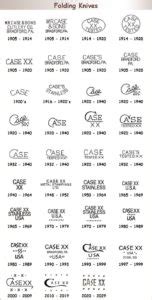The Ultimate Case Knife Dating Cheat Sheet: Decoding Your Collectible
Case knives, with their rich history and enduring craftsmanship, are coveted collectibles. But determining the age and value of your Case knife can be tricky. This ultimate dating cheat sheet will equip you with the knowledge to decipher your knife's past and understand its worth. We'll explore various marking systems, common variations, and crucial details to look for. Whether you're a seasoned collector or just starting your journey, this guide will be your invaluable resource.
Understanding Case Knife Markings: The Key to Dating
Case knives employ a variety of markings to identify their age and features. These markings are your primary tools for dating. Let's break down the most important ones:
1. The "XX" Code: A Cornerstone of Case Knife Dating
The "XX" code, etched onto the blade, is a crucial identifier. This code represents a specific year of manufacture. However, understanding this code requires familiarity with Case's production history, as the system changed over time. There are numerous online resources and Case collector communities dedicated to deciphering these codes – these should be consulted for the most accurate dating. Be aware that there are variations and inconsistencies, so cross-referencing is highly recommended.
2. The Pattern Number: Identifying the Knife Model
Each Case knife features a pattern number, indicating its specific design and configuration. Knowing the pattern number helps narrow down the timeframe of production. Certain patterns were only made during specific periods, assisting in more precise dating. You’ll usually find the pattern number on the blade or tang.
3. The Shape and Style of the Blade: Visual Clues to Age
The shape and style of the blade can be surprisingly informative. Case has employed different blade shapes and styles over its long history. Certain shapes are strongly associated with particular eras. While not foolproof on its own, combining this visual information with other markings enhances accuracy.
4. The Handle Material and Construction: Material Matters
The type of handle material and its construction (e.g., jigged bone, stag, pearl) significantly influences dating. Certain materials were more commonly used during specific periods. Moreover, handle construction techniques evolved over time, providing additional clues.
5. The Box and Packaging: Contextual Evidence
While not directly on the knife itself, the original box and packaging can offer invaluable information. Look for any markings, labels, or printing that could pinpoint the manufacturing date or era. The style of the box itself can often be correlated with particular periods.
Common Case Knife Variations and Their Dating Challenges
Case's long history features several variations in markings and manufacturing techniques, often leading to dating challenges. Some examples include:
1. Early Case Knives (Pre-XX Code System): Dating these knives necessitates a different approach, relying heavily on blade style, handle materials, and often, expert consultation.
2. Transitional Periods: When Case altered their marking systems, the resulting period can be difficult to definitively date. Carefully examining all available markings and cross-referencing resources is vital.
3. Re-bladed or Repaired Knives: A Case knife with a replaced blade or significant repairs can complicate dating. It’s essential to distinguish between original features and later additions.
How to Use This Information Effectively
This cheat sheet is a starting point. Successfully dating a Case knife requires a multifaceted approach:
- Carefully examine all markings: Take high-quality photographs of all markings on the knife, handle, and box.
- Consult Case knife reference books and online resources: There are many dedicated resources that catalog Case knives and their marking systems.
- Join Case knife collector forums and communities: Experienced collectors can often offer invaluable insights and assistance.
- Consider professional appraisal: For particularly valuable or challenging knives, consulting a reputable knife appraiser can be beneficial.
By utilizing this information and adopting a systematic approach, you can successfully uncover the fascinating history behind your Case knife. Happy hunting!
Frequently Asked Questions (FAQs)
How can I find the value of my Case knife?
The value of a Case knife depends on several factors: its age, condition, rarity of the pattern, and the materials used in its construction. Consulting price guides, online marketplaces (with caution), and professional appraisers are essential for accurate valuation.
Are there any common fakes or reproductions of Case knives?
Yes, there are counterfeit Case knives in circulation. Be aware of inconsistencies in markings, materials, and overall craftsmanship. Authenticity verification should involve careful examination and potentially expert consultation.
Where can I learn more about Case knife history?
Case's official website is a good starting point, but deeper dives can be found through collector websites, books specializing in Case knives, and the aforementioned communities.
How should I care for and maintain my Case knife?
Proper care involves regular cleaning and oiling to prevent rust and preserve the blade and handle. Keep your knife in a protective sheath or case when not in use.
This comprehensive guide serves as a foundational resource for dating your Case knife. Remember to approach the process methodically, utilizing all available information and resources to accurately determine the age and value of your collectible.

